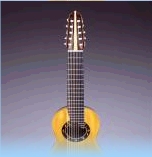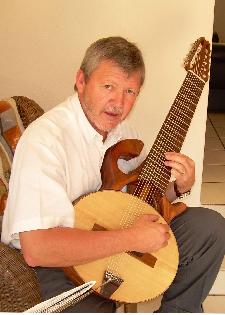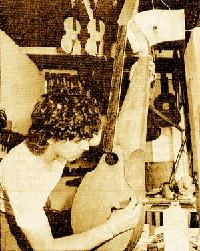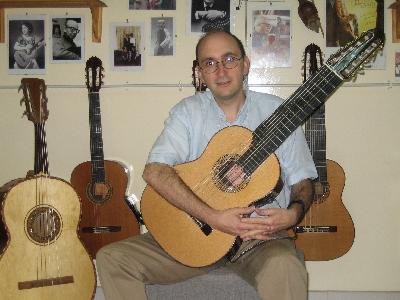World-renowned 10-string performer, recording artist and composer, Janet Marlow “showing off ” her new Janet Marlow Entry Model 10-string classical guitar, presented to her by Michael McBroom] Fortunately, this airplane was a De Havilland Dash-8, a small, 36-seat turboprop. So small that it doesn’t fit up to those extendable entrance/exit ramps that we’ve all become so used to. You have to walk out on the tarmac up to the plane and board it via a ladder — just like they used to do in the old days and heads of state still do to this day. I say this was fortunate because a baggage handler was standing next to the plane, ready to take carry-on baggage that would not fit in the overheads or beneath the seats, so he could stow it in the cargo area. I walked up to this guy, and pointed across the tarmac to the train with my guitar still sitting on it. “You see that big cardboard box over there with all the FRAGILE stickers all over it?” I said. “That’s part of my luggage.” The handler asked if I was sure, because a lot of boxes look alike, and I replied I was absolutely sure. He then admitted that they didn’t know who that luggage belonged to. Probably because of the cancelled flight, I suspect. To give credit where it is due, he walked over to the abandoned luggage train to check. Satisfied, I boarded the plane. A few minutes later, sardined into my seat, I heard the sounds of a lot more luggage being stowed, not just mine. I reckon I saved the airline a lot of grief by not listening to that gate attendant. The guitar and I made it into New Haven, and later to my hotel without further incident. And I was happy to find, upon unpacking the guitar, that it had made the journey without mishap.
THE FESTIVAL This year, the festival was held at Sacred Heart University, in Fairfield, Connecticut. The Sacred Heart staff were warm, courteous, and helpful, and made sure the festival ran smoothly. The seminars were conducted in one of the music rooms, which was equipped with a computer-ready overhead projection system that made showing visuals a breeze.
Janet Marlow www.janetmarlow.com, the Festival director, opened the Festival with an introduction, in which she spoke about the importance of the 10-string guitar to the music community and how, as 10-string players we wore several hats. By necessity, in addition to being a musician who plays the 10-string, an accomplished 10-string player is an historian, an arranger, a composer, and an improviser. Many classical players who have received “traditional” training have had scant exposure to the latter two areas, but they are, to my way of thinking, perhaps the most important when considering the advancement of the instrument. After all, what is musical composition but improvisation frozen in time? And, given the small body of work written for this particular instrument, the emphasis on composition becomes an important one.
Janet began her discussion with nail shapes. She prefers shaping her nails the way Narcisso Yepes shaped his, which to perhaps overly simplify things, involves giving the nail edges more of a rectangular shape instead of the more traditional rounded shape. By doing so, greater contact between the fleshy tip of the finger and the string is maintained without sacrificing the power and clarity of the nail, whether using rest stroke or free stroke, and a fuller sound is the result. There is also less of an occurrence of the click one often hears when a string is plucked using the rounded shape. To make this shape work to its optimum, it must be tailored to each nail, which is due to the arc a finger describes as it approaches a string. With most players, only the middle finger strikes a string at a more-or-less perpendicular angle. All the others approach the string at a more oblique angle. Thus, only the middle finger’s nail receives a straight-across rectangular shape. The index finger’s shape is a bit more rounded on the edges. The ring finger’s nail is shaped at a slight slant toward the guitar bridge — you can see why this is when you look down at your “a” finger as it plucks a string. And finally, the thumbnail is beveled in the opposite direction to eliminate clicks and to increase the contact of the fleshy part of the side of the thumb with the string.
Janet also discussed right hand positioning and the importance of its role in controlling dynamics, timbre, and unwanted string vibrations, the latter being a very real concern for 10-string players. She explained that when playing a piece, simply “playing what you feel” isn’t enough. One must have a knowledge of the historical perspective, the musical style of the period, as well as the composer’s preferences, when interpreting a piece of music on the 10-string. Since much of this involves dynamics and timbre, her inclusion of this topic was appropriate within the context of right hand technique.
Another closely related topic was voicing with the right hand. This is not specific to the 10-string, but is just good musicianship, and she emphasized its importance. One should practice playing through a series of four note chords, and be able to bring out each voice in turn, such that it is obvious where the melody is.
Regarding left hand technique, she advocates keeping the same or similar arc to the fingers when transitioning from upper to progressively lower strings and that one can move ones left arm in or out to maintain this. This is straight from Narciso Yepes’ playing philosophy.
Janet stressed the importance that both the right and left hand of the ten-string guitarist should be skilled at playing in a full 360 degrees of movement for making decisions regarding volume, sound and timbres according to an intellectual analysis of the music and the composer's intentions.
Janet's talk also included useful techniques for improving ones speed when playing scale passages. She used a "bouncing ball" analogy to show how, the higher a ball bounces, the more time there is between bounces, and the closer the ball gets to the ground, the less time between bounces. This emphasizes in a very clear way the importance in keeping ones fingers for both the left and right hand close to the strings. To improve speed, she advocates working on passages by starting with the first three notes, then adding one note at a time, but adding notes to the passage only after the mind and ear is satisfied with the precision and velocity of the scale segment.
Pascal Boëls, from Paris, France is a specialist on the interpretation of Renaissance and Baroque music, and its application to the 10-string guitar. I found his insights on interpreting and performing trills and other ornaments to be especially valuable. He decried the use of trills played with metronomic precision, and emphasized the importance of accelerating a trill as a way of building up a level of tension to its sudden conclusion. Pascal indicated some of the works of J.S. Bach which had been transcribed for more than one instrument, and pointed to the manner in which string players will play trills and other ornaments in a different fashion than the way the same ornaments are interpreted for keyboard. For the non-trill ornaments, essentially he emphasized the double-dotted rhythms that are so characteristic of Baroque interpretations.
Friday’s seminars began with a talk by Dennis Cinelli www.cinellimusic.com, the guitar professor at Montclair State University[http://montclair.edu], in Montclair, New Jersey, and a renowned performer of period music. Dennis is an authority on the guitars and lutes of the Renaissance, Baroque, and Romantic eras. He brought three instruments to the festival: an 1843 Panormo, a circa 1830 Stauffer, and a copy of a circa 1856 Scherzer 10-string, built by the Russian luthier, Alexandre Golubostskij. His talk included a comprehensive overview, complete with many photos, of the evolution of the guitar from its earliest beginnings to its present configuration.
His presentations emphasized the widespread use and popularity of multi-stringed guitars during the late 18th century, throughout the 19th century, and into the 20th century. Dennis contends that, in order to play many of the pieces written by Ferdinand Carulli (1770-1841), the inventor of the decacorde, and Napoleon Coste (1810-1883), a 10-string is necessary to give them a faithful rendition. After his presentation, Dennis played all three instruments. Despite their small size relative to a modern classical and shorter scales (ranging from 630mm to 640mm), the guitars had surprisingly good volume, and a rich, warm sound.
Friday’s afternoon session began with an improvisational workshop led by Grammy Award nominee and world-renowned cellist, David Darling.www.daviddarling.com David’s workshop was not just improvisational, it was inspirational. A man of remarkable talent and compassion, he brings every bit of it to the fore when he engages his workshop participants in an area that too many people, especially classically trained musicians, find intimidating. For those of us who were game enough, each of us was invited to do a bit of improvisation. I decided not to let the opportunity pass me by and gave it a shot, and I’m glad I did. Then he broke the group down into smaller groups of four, with himself as one of the participants, and then directed each into exploring their instruments in a very relaxed and unintimidating fashion, and before long everybody was “doing their thing.” Finally, he had the entire group going, once again introducing simple elements and building upon them until we were all having a good time. And that seems to be at the core of David’s philosophy toward improvisation. Having a good time. Enjoying ones instrument. Having the belief and conviction that the music is already out there, and all a player has to do is reach out, even if just a little at first, and touch it.
Steve Adelson www.steveadelson.com gave us a demonstration of the remarkable capabilities of the Chapman Stick.[http://www.stick.com] The model he prefers is called the Grand Stick, which has 12 strings in 12 courses, tuned B E A D G C C# F# B E A D, with the lowest string being the C in the center. The strings on either side of the low C ascend in 5ths outward on the low strings (or the bass side of the fingerboard), and descend in 5ths inward on the high strings (or the treble side of the fingerboard). The advantage to this tuning, Steve explains, is the symmetry that is maintained. Chord shapes are the same above and below the low C, and across all strings, so ones repertory of chords is drastically reduced compared to what guitarists have to familiarize themselves with. Dots are located on the fingerboard every five frets, so it is an easy matter to relocate a chord from one position to another. All one has to do is move up (or down) five frets, then move the position up (or down) a string, and voila! The same chord, with the same fingering can be played in the new location. Steve runs his Stick through two amplifiers, one for the bass side and one for the “guitar” side. His Stick incorporates an RMC pickup module for the upper six strings, which allows him to run it through a Roland VG-88 effects unit or Roland GR-33 guitar synthesizer.
Steven is a very talented player, demonstrating the capabilities of the Stick by playing complex bass lines while chording and soloing over them. A true professional, he made it look as easy as falling off a log.
Saturday’s sessions began with a talk on the skills of transcribing the music of Weiss, Bach, and piano scores to the 10-string. This was a panel discussion, in which certain basics were emphasized, especially paying careful attention to bass lines, whether there in actuality or intent.
Inside the Janet Marlow Entry Model, showing the McBroom radial bracing system]
Next, yours truly www.michaelmcbroom.com gave a talk on guitar construction, with a particular focus on building 10-string guitars and the different construction methods that go into their fabrication. I had the benefit of using the projection equipment to show photos of my work on two 10-strings at various stages of completion, both of which were at the festival. My lecture included my general philosophy regarding 10-string construction, as well as several specific steps I take in the building process of 10-strings that I have learned from both experimentation and trial and error There was quite a bit of discussion regarding various aspects of the building process specific to 10-strings. Even though only one of the attendees of the festival this year, David Starbuck, has built guitars, I believe it is beneficial even for a player who has no intention of building guitars to understand some of the process. It helps to make a better informed consumer, as it were, when or if they are shopping for guitars in the future, especially 10-strings.
[michele2a.jpg – caption: Michéle with his DiCarlo 8-string]
Later a talk and demonstration was given by Michéle Ramo www.ramomusic.com (pronounced Me-KAY-lay). His lovely wife, Heidi Hepler-Ramo, also attended. She is an excellent singer, with an irrepressible sense of humor that kept smiles on all our faces.
Michéle, originally from Sicily, and now living in Queens, New York, studied and played classical violin for many years, and taught himself how to play guitar. His guitar style is what we often call “crossover” now, employing elements of classical, jazz, and a variety of ethnic melodic and rhythmic structures. He has developed an approach to his music that is not unlike that of Steve Adelson’s, in terms of the resulting sound, but the method is entirely different. Working together with New York-based luthier Rich DiCarlo, Michéle developed a unique 8-string guitar. The upper six are essentially a standard six-string classical, but the lower two are tuned to D and A. The 8th string, tuned to D, is fully two octaves below the open 4th string, and the 7th string, tuned to A, is an octave below the open 5th string. The fingerboard below these two strings is fretless, and the result is a sound that very closely resembles that of an upright bass. Also like Steve, Michéle plays his guitar through two amplifiers. His guitar uses RMC piezo saddle transducers, with separate modules for the lower six and the two basses.
Michéle played a few excerpts from his repertory of jazz tunes, most of which were old standards. His musicianship is simply superb, and it was really quite amazing to hear jazz chords and melody played on a classical with the deep sound of a stand-up bass in the background — all while watching it being performed by one person.
After Michéle's presentation, somebody suggested a jam session. I think it was Dennis. Regardless, it was a unique pleasure to watch Blue Bossa being played on a couple of 10-strings and an 8-string by three very talented players.
Joe Carter www.joecartermusic.com is the resident guitar instructor at Sacred Heart University. Although he plays (only) a six-string classical, nobody at the seminar minded because his talk was valuable for anyone interested in learning more about latin rhythms, especially those from Brazil. As a sometimes player of jazz and latin music, I was very interested, and so was everyone else, by all appearances.
Joe began his talk by giving a brief overview of the history of the bossa rhythm and its originators — João Gilberto and Antonio Carlos Jobim. Prior to the advent of the bossa, typical Brazilian music was marked by a perhaps overabundance of percussion and, of necessity, shouted lyrics. Gilberto had the inspiration to bring down the dynamic level and distill the rhythms to their simple essences, such that the music was played softly and the lyrics were almost whispered. Think “Girl from Impanema.” Just by doing this, Gilberto and Jobim revolutionized the world of latin music.
Using a Power Point presentation, Joe displayed the basics of bossa, samba, and baião rhythms and variations on each. One observation he related, based on his own personal experiences when playing in Brazil, was the importance of getting away from 4/4 and developing a 2/4 feel for the music. He showed how 4/4 emphasis made the music sound more like a march, and how, just by emphasizing a 2/4 feel, the music began to glide.
Joe’s talk also included basics on jazz chord substitutions, which was appropriate since most Brazilian music follows similar chord theory as used in American jazz. Both the rhythmic and harmonic elements of Joe’s talk were essential information for really any guitarist who is interested in composition, especially if one wishes to compose in a latin style.
Janet Marlow adds " On Sunday morning Michael had to catch an early flight. However there was an additional hour and a half workshop given by Dr. Keith Zeitlin, ND on health for guitarists. It was a very deep discussion amonst those who were there. There are so many concepts that even Keith as a naturopathic doctor understands within his own field that are misleading and does not take into account the whole picture of the person. In a very profound way the parallels between his field of medicine and the multi-string world were amazingly synchronized. We all left the workshop with a stronger sense of community and the festival was officially completed until the next time. My only regret is that I did not have Dr. Zeitlin speak to all of us on the first day. However, he is now the official doctor advisee of the International Society and I have asked him to submit an article so that you can all share his wisdom" .
The Concerts
Following are the programs for the concerts that were given on Friday and Saturday nights with a few photos of the perfomers:
The International Ten-String Guitar Festival Concert July 7, 2006 Presents“400 Years of Guitar into the Future” Sponsored by Janet Marlow Music LLC, The Edgerton Center for The Performing Arts at Sacred Heart University
Pascal BOËLS (France) 10-string classical guitar
John Dowland "My lord Willoughby's welcome home" "The most sacred Queen Elizabeth, her Gaillard" "Lachrimae Pavan" "Forlone Hope Fancy" "A Fancy" Adagio and Fuga (BWV.1001) J.S. Bach
[dennis1a.jpg] Dennis Cinelli Romantic 10-String Guitar 19th c. Mazurka - Polonaise Op. 3 J.K. Mertz
Trois Nocturnes Op. 4 J. K. Mertz Notturno Andante con moto - Piu mosso Notturno II Andantino - Allegro con brio Nocturno III Maestoso – Vivace 10 string guitar by Alexandre Golubotskij (Moscow, 1990) after J. G. Scherzer (Vienna, 1856) from the Patrick O'Brien instrument collection. Mr. Cinelli's performance is made possible by the generous support of E. & O. Mari, Inc. / LaBella Strings
Intermission
Steve Adelson 12-String Grand Chapman StickThis performance entails varied improvised and original compositions on his 12 string Grand Chapman Stick. The Stick is a multi-stringed fret board with a unique inverted tuning that primarily employs a piano-like tapping technique by the player. He will demonstrate the accompanying two handed tapping style which allows him to play melodies, improvs, harmonies, chords and rhythms all simultaneously in real time. Steve will also offer a brief description of the Chapman Stick's revolutionary tuning scheme and its benefits for sonic creativity.
Janet Marlow 10-String Classical Guitar Preludio, Vals 1, Vals, 2 Choro Comp. Carmen Guzman (Argentina) Sweet Sensations comp. Janet Marlow [janetpascal1a.jpg]
Janet Marlow and Pascal BOËLS Duo Mozart Table Music
Janet Marlow and Alan Brennan violin La Romanza Anon. arr. Janet Marlow Over The Rainbow arr. Janet Marlow
The International Ten-String Guitar Festival Concert July 8, 2006 Presents “400 Years of Guitar into the Future” Sponsored by Janet Marlow Music LLC, The Edgerton Center for The Performing Arts at Sacred Heart University
Dennis Cinelli Romantic 10-String Guitar 19th c. Etudes de Genre Op. 38 N. Coste No. 12 Prélude No. 2 Scherzando No. 22 Tarantelle Kindermärchen Op. 13 no. 8 J. K. Mertz Liebeslied Op. 13 no. 4 Le Gondolier Op. 65 no. 3 10 string guitar by Alexandre Golubotskij (Moscow, 1990) after J. G. Scherzer (Vienna, 1856) from the Patrick O'Brien instrument collection. Mr. Cinelli's performance is made possible by the generous support of E. & O. Mari, Inc. / LaBella Strings [pascal4a.jpg]
Pascal BOËLS (France) 10-string classical guitar J.S.BACH (1685-1750) Prélude, Sarabande, Gavottes1and 2 (BWV.1012) Sarabanda and Ciaconna (BWV.1004)
Intermission
MICHÉLE RAMO (Italy) 8-String Jazz Guitar MICHÉLE RAMO is performing on an 8 string nylon finger style jazz .A classical-jazz crossover artist in the truest sense of the word, Ramo has a unique and sought-after ability for blending his classical and jazz worlds into his writing, teaching and performance. His 8-string guitar was created by Luthier, Rich DiCarlo and Michele Ramo.
Janet Marlow 10-String Classical Guitar Three American Landscapes comp. Janet Marlow Blue Eyes comp. Janet Marlow
Janet Marlow 10-string & Alan Brennan, violin Norwegian Wood Recuerdos de la Alhambra arr. J. Marlow
I can speak only for myself, but I thoroughly enjoyed this year’s festival and getting to meet the talented players who attended the event. I’m already looking forward to the next one, and I hope to see more players, whether they play a 10-string or are simply interested in multi-stringed guitars and music, at the next event. I would also like to add a special "thank you" to Janet Marlow and Stephen Rekas for providing several of the photos shown in this article.
Michael McBroom Houston, Texas July 12, 2006
Thanks for all your hard work and dedication, Janet!
Copyright © 2006 Michael McBroom, all rights reserved










